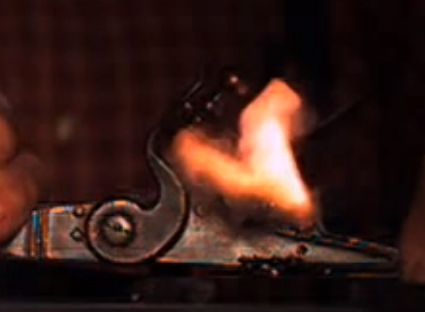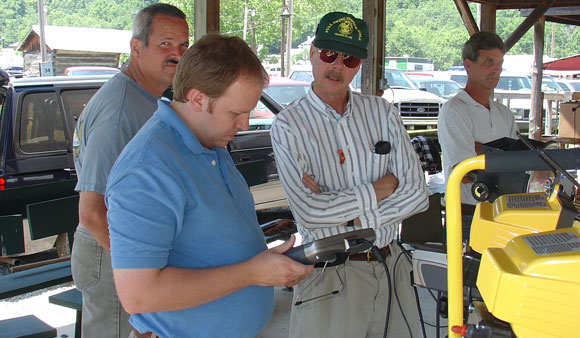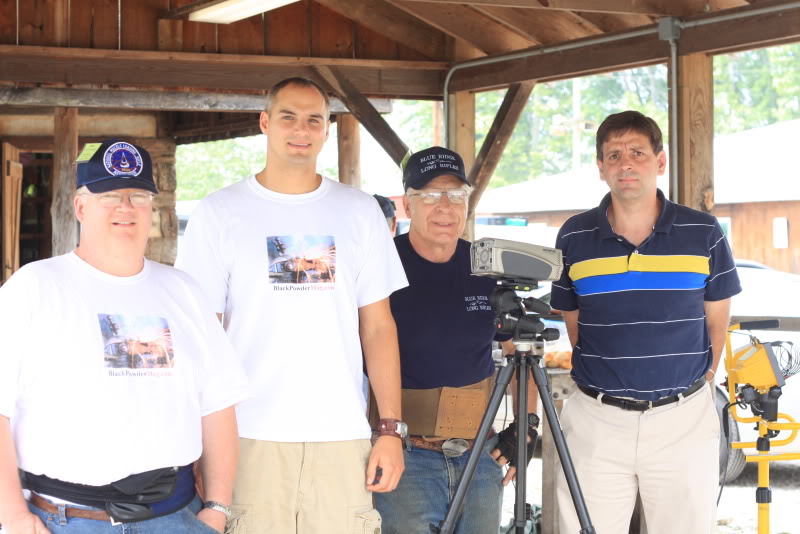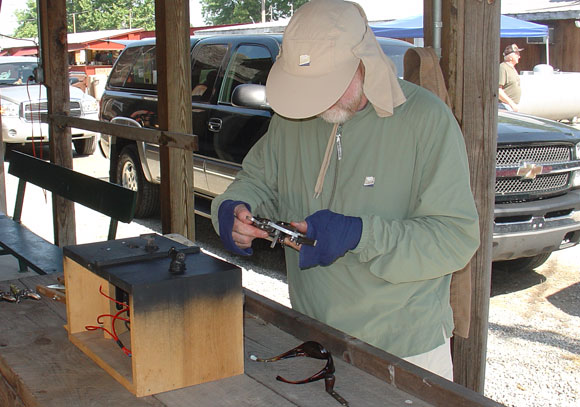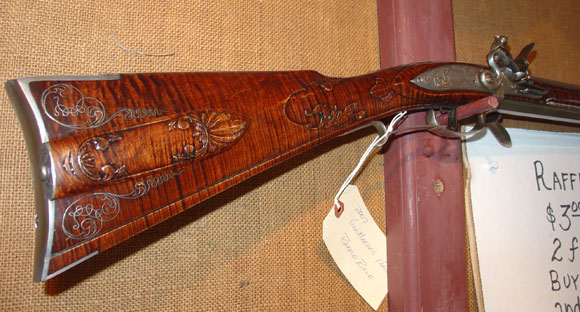This is the complete flintlock video library of the high speed film done at Friendship during the spring of 2007. Earlier articles contained highlights – like the original Manton supplied by Jim Chambers. Finally they are all together. Now we can watch black powder ignite!
The video links in thie article are more of the film we did at Friendship. As in earlier video, the frame rate is 5000 frames per second. This rate allows us to watch lock parts and see the very beginning of the ignition sequence. In earlier videos we looked at an original Manton and a wheel lock. Here we pursue more locks of different types and makers, as well as a study of flint wear done by Lowell Gard.
David Price has just fired a flintlock for the camera.
David Price does the honors again, firing the locks as Grant Ferguson does the camera work. Grant is the rep from Olympus. David was great help all day long. He felt, as did I, that the same person should prime all the locks.I appreciated having such experienced help.
Grant Ferguson, Olympus Industrial, is shown working with the camera interface.
From my experimenter’s point of view this was a great day. We gathered a wealth of material from which to draw data, and I think we proved that this media could be used to improve lock function. Another experimenter feels the same way. Lowell Gard of “Bevel Bros.” fame asked if we could video his lock with varying numbers of trials on the flint. He wanted to see if we could see the flint deteriorate as the trials increased. We started with a new flint and worked up to 50+ trials.
Lowell Gard (left) and David Price (center) discuss the project with another observer.
Below are five links to high speed videos in which a number of locks are grouped by type or maker. Start the links by clicking twice on the center arrow.
Ketland Group—- This group includes three locks. The first two are done by Dennis Preddy. His first is an unmodified late Ketland lock. The second was modified by Preddy. The remaining video is Lowell Gard’s experiment. We first did a video of his Late Ketland with a new flint. Lowell then snapped the lock 10 times and we did the next video. We continued this until we exceeded 60 snaps.
Priddy/Late Ketland (unmodified)
Priddy/Late Ketland (modified)
Gard/Late Ketland (new flint)
Gard/Late Ketland (11 snaps of flint)
Gard/Late Ketland (32 snaps of flint)
Gard/Late Ketland (63 snaps of flint)
The Chambers Group —- This group (below) came from Jim Chambers. It contains four locks. The original Manton came from a double fowler and is perhaps the most important lock we filmed.
Chambers Golden Age
Robert Harn
Round faced English
Original Manton (fowler w V pan)
The Kanger Group —- The Kanger group below has five locks. The Roller and Haddaway are important locks to study, in my view.
Kanger/Bob Roller
Kanger/Haddaway (note that there is no frizzen rebound)
Kanger/La Page
Chambers Round face
Chambers Round Face (up-side-down)
Pletcher/Jerry Eider
Assorted Group #1 —- The Assorted group (below) again has a number of locks:
Bauer left hand lock (maker ??)
Pedersoli
Pedersoli
L&R Trade lock
L&R Manton
Assorted Group #2 —- The locks included below are as follows:
Buckwalter Wheellock
Coggeshall (maker??)
Coggeshall (Chambers Roundface??)
Mortimer Pedersoli
Dale (L&R??)
Dale (Davis)
Dale (Sales)
Locks and Swivel Guns by David Price —- This group of locks come from David Price – both conventional locks and those on his swivel breech guns. They include:
Price Double Rifle
Price large Siler
Price Siler 40
Price Siler Rifle
Same Price rifle (up-side-down)
I wish to thank Grant Ferguson for his effort in this project. Without his camera and special abilities, we certainly could not have attempted this. Grant, I hope we get a chance to work together again. David Price worked all day long with me, and I appreciate his help. I also thank him for the opportunity to handle his beautiful swivel breech. Thanks also to Barbie Chambers and Dick Miller for allowing us to work at Gun Makers’ Hall. And last of all, a thank you to all the shooters who brought locks for us to record. I appreciate your willingness to share your lock with us.
